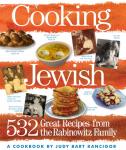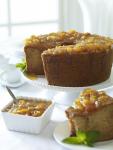
BUY COOKING JEWISH by clicking here now.
Rosh Hashanah
Israeli Carrot Salad
from "The Foods of Israel Today" by Joan Nathan
as seen in The Orange County Register, 9-14-01
2 cloves garlic, peeled
8 sprigs (1/2 bunch) fresh parsley, stems removed
1 pound carrots, peeled, cut into 1- to 2-inch lengths
2 tablespoons lemon juice
2 tablespoons orange juice
4 tablespoons extra-virgin olive oil
1/2 teaspoon salt
Several grinds of pepper
Cook's note: You can add orange slices and/or radish slices to garnish this salad. Add grated or julienne celery root with the carrots in winter.
- Place garlic and parsley in food processor fitted with steel blade; process until chopped.
- Add carrots, lemon juice, orange juice, oil, salt and pepper.
- Pulse until carrots are well-chopped but not puréed.
- Adjust seasonings and serve.
Yield: 6 servings
An Israeli mosaic
from The Orange County Register
September 14, 2001
by Judy Bart Kancigor
When Hana Lustigova Greenfield returned to her native Czechoslovakia in 1945 after liberation from Bergen-Belsen concentration camp, she miraculously found her sister, then her rabbi, who was preparing the synagogue for Rosh Hashanah (the Jewish New Year). He had the sisters cut an apple and dip the slices in honey, telling them, "As bitter as was our past life, we should have a sweet future."
Just one of hundreds of stories in "The Foods of Israel Today" (Knopf $40), the latest book by Joan Nathan, the award-winning author of "Jewish Cooking in America" and host of the PBS TV series of the same name. More than a cookbook, it is an exhaustively researched and compellingly told saga of a vibrant land and its diverse people, from its rich ancient history through its beleaguered present.
Nathan is a tireless investigator and a good listener. She entered the kitchens of both ordinary Israelis and popular restaurants, gathering stories to accompany the 300 recipes from Jews, Christians and Moslems.
Nova Scotia Honey Orange Sponge Cake
From Cooking Jewish: 532 Great Recipes from the Rabinowitz Family (Workman) by Judy Bart Kancigor
Preorder on amazon
 Rosh HashanahMy mother got this recipe from her friend Corinne in Nova Scotia. I remember visiting with them the summer before I turned fourteen, when I absolutely refused to go to sleep-away camp anymore. I traveled with my parents as they sang their way through the Catskills and Berkshires and then ferried up to Nova Scotia. The most memorable part of the trip for me was the arrival of Princess Margaret, who almost killed herself stepping out of her shoe as she exited the helicopter. For my mother, the most impressive moment was when Corinne sent her mother out into the yard to dig up potatoes for our dinner.
Rosh HashanahMy mother got this recipe from her friend Corinne in Nova Scotia. I remember visiting with them the summer before I turned fourteen, when I absolutely refused to go to sleep-away camp anymore. I traveled with my parents as they sang their way through the Catskills and Berkshires and then ferried up to Nova Scotia. The most memorable part of the trip for me was the arrival of Princess Margaret, who almost killed herself stepping out of her shoe as she exited the helicopter. For my mother, the most impressive moment was when Corinne sent her mother out into the yard to dig up potatoes for our dinner.
Roasted Eggplant And Pomegranate Seed Salad
from "The Essential Book of Jewish Festival Cooking" by Phyllis Glazer and Miriyam Glazer
Serves 6
If your stovetop is electric, the next-best thing is to broil the eggplants on an oven rack close to the broiler element until blacked, turning occasionally. Place a parchment-lined pan under them to keep the oven clean. Serve with challah, hot pita, toast, or crackers.
4 pounds eggplant (about 3 large)
2 tablespoons freshly squeezed lemon juice, or more to taste
Seeds of one pomegranate
1/2 cup extra-virgin olive oil
Salt and freshly ground black pepper to taste
1 tablespoon chopped fresh mint leaves (optional)
3 to 4 tablespoons chopped green onions and/or sliced radishes
Wash and dry eggplants. Cut a hole in middle of three large squares of aluminum foil to form “collars” for three stovetop gas burners. (This will help alleviate cleanup.) If you have them, place a rack over each burner to hold the eggplant. (Cooling racks may also be used).
Put an eggplant on each one of the burners and roast over medium heat, turning occasionally, until blackened on all sides. Use two large kitchen spoons to transfer one eggplant at a time to a cutting board. Let cool until easy to handle.
Slice each eggplant in half lengthwise and use a spoon to scrape out insides. Discard skin. Hand-chop eggplant flesh with a chopping knife until there are no coarse lumps or strips, then transfer to a bowl. (Don’t be tempted to use a blender or food processor for this recipe – they destroy the texture.)
Using a fork, mix in the lemon juice and pomegranate seeds, then gently whisk in the olive oil. Season to taste with salt and pepper. Pour onto a large plate and garnish with chopped mint in the middle and chopped green onions or radish slices over the rest.
The Best Honey Cake Yet
from "The Essential Book of Jewish Festival Cooking" by Phyllis Glazer and Miriyam Glazer"
Makes one 12-inch loaf or two 9-inch loaves
If there is one food on everyone’s Rosh Hashanah menu, it’s honey cake. One of the Seven Species of the Bible, honey symbolizes the wish for a sweet New Year. “Inspired by the Romanian-Jewish honey cake – which is light rather than dark – this version is light as a feather and really delicious. It’s certainly the best honey cake we’ve ever tasted,” write Phyllis and Miriyam Glazer.
1 cup walnuts or pecans, chopped
1/2 cup vegetable oil
1 1/4 cups honey
6 large eggs, separated
1/4 teaspoon cinnamon
1/4 teaspoon ground ginger
Pinch of ground cardamom
2 cups unbleached all-purpose flour
1 tablespoon baking powder
1/2 cup sugar
Preheat the oven to 375°F. Lightly grease a 12-inch loaf pan or two 9-inch loaf pans. Line bottom and sides with parchment paper to facilitate removal after baking. Set aside.
Place chopped nuts in a baking pan and roast in oven for 10 minutes, shaking pan occasionally. Remove from oven and let cool.
Lower heat to 300°F.
In bowl of a standing electric mixer, beat oil, honey, egg yolks, and spices. Sift flour and baking powder and blend into honey mixture until smooth.
In separate bowl, beat egg whites until foamy. Add sugar gradually, continuing to beat until egg whites are stiff. Fold a small amount of egg whites into honey mixture, then fold in the rest gradually, mixing gently each time until incorporated Stir in nuts.
Nature's cues signal Rosh Hashanah
The Orange County Register
September 9, 2004
by Judy Bart Kancigor
When the exotic yellow Barhi date first appears in the open-air markets of Israel, no one needs a calendar to sense that Rosh Hashanah, the Jewish new year, is approaching. So, too, did the ancient Hebrews mark the seasons with cues from nature - the ripening of wheat in spring, the profusion of figs in summer, pomegranate harvest in fall, the pressing of olives in winter.
Rosh Hashanah, which starts at sundown Sept. 15, began as an agricultural festival and might have remained so if not for the destruction of the Second Temple by the Romans, which forced the Jewish people into exile. "The Essential Book of Jewish Festival Cooking" by Phyllis Glazer with her sister, Miriyam Glazer, (HarperCollins, $29.95), explores, through mouthwatering recipes and their fascinating origins, how the holidays were remolded by the rabbis and sages in the Diaspora.
"There were no familiar signs of nature for the people to follow in their new land," Phyllis Glazer explained, visiting from her home in Israel, where she is a cookbook author and well-known food journalist. "The rabbis sought to save the holidays and give them other meanings.''
"There's a beautiful line in one of the Psalms: 'How can we sing the Lord's song in a strange land?' " added Miriyam, a professor of literature and a rabbinical student at the University of Judaism in Los Angeles. "And so the rabbis looked for scriptural evidence in the Bible itself in order to preserve the festivals."
Spiced Pear and Almond Cake
From “Jewish Holiday Feasts” by Louis Fiszer and Jeannette Ferrary
4 cups cored and coarsely chopped ripe pears (5-6 pears)
2 cups sugar
1/2 cup vegetable or canola oil
2 eggs, beaten
2 cups all-purpose flour
1 teaspoon ground cinnamon
1/2 teaspoon grated nutmeg
Grated zest of 1 lemon
2 teaspoons baking soda
1/2 teaspoon salt
1 teaspoon vanilla extract
1 cup chopped blanched almonds
Confectioners’ sugar
Preheat the oven to 350° F. Grease a 10-inch round cake pan.
Combine pears and sugar in medium bowl and let stand 15 minutes.
Combine oil with eggs and add to pears.
In another bowl, combine flour, cinnamon, nutmeg, lemon zest, baking soda and salt. Stir into pear mixture. Add vanilla and almonds.
Pour into prepared pan and bake until cake tester inserted in center comes out clean, about 45 minutes. Cool on a rack about 20 minutes before turning out. Invert onto a serving platter and dust with confectioners’ sugar.
Serves 12
Sweet Ravioli with Bitter Honey
from Sweet Myrtle and Bitter Honey: The Mediterranean Flavors of Sardinia
(Rizzoli International) by Efisio Farris with Jim Eber.
Makes 12 to 16 pastries
3 1/4 cups all-purpose flour
1/2 teaspoon salt
1 whole egg and 2 egg yolks, divided
1/2 cup extra-virgin olive oil
1 1/2 cups fresh sheep's milk ricotta cheese (or other creamy ricotta cheese, about 3/4 pound)
1/2 cup sugar
Zest of 1 lemon, finely grated
Zest of 1 orange, finely grated
1/2 cup bitter honey
Vegetable oil for frying
Powdered sugar for dusting
On a clean workspace, mound the flour with a well in the center. Sprinkle the salt evenly over the flour. Add the whole egg and 3/4 cup warm water into the well and gradually mix into the flour with your Hands. When the mixture begins to come together, add the olive oil and knead to fully incorporate. Cover dough with a cloth and let rest at room temperature for 1 hour.
In a mixing bowl, combine the ricotta, sugar, egg yolks, and zests.
On a lightly floured workspace, roll out the dough to a rectable about 1/4 inch thick. Using a sharp paring knife or a large cookie cutter, cut into 3-inch-diamter rounds. Reroll the scraps and cut again as necessary. You should end up with between 24 and 32 rounds.
Set aside half of the rounds. With the remaining rounds, lightly mound about 2 tablespoons of the ricotta mixture into the center of each. Top with the other dough rounds and lightly press edgees together, crimping edges with a fork to seal. Lightly dust the ravioli with flour to prevent sticking and set aside.
In a saucepan over low heat, warm the bitter honey.
Fruit Salad With Honey, Figs And Dates
from "A Feast from the Mideast" by Faye Levy
as seen in the Jewish Journal of Greater Los Angeles
story by Judy Bart Kancigor
Makes 4 servings.
1 to 2 tablespoons honey
1 to 1 1/2 tablespoons fresh-squeezed lime or lemon juice
1 tablespoon water
1 banana
2 peaches or ripe pears
2 cups halved or quartered fresh figs
1 cup plump, good quality dates, such as Medjool or very soft, fresh Barhi
1 to 2 tablespoons slivered almonds, toasted
- Mix 1 tablespoon honey with 1 tablespoon lime juice and water in serving bowl. Peel and slice bananas; add to bowl.
- Cut peaches or pears in wedges and add them. Add figs and dates. Mix gently. Add remaining honey and lime juice if you like. Refrigerate until ready to serve.
- Serve topped with almonds.
Almond Apricot Basmati Rice
from "A Feast from the Mideast" by Faye Levy
as seen in the Jewish Journal of Greater Los Angeles
story by Judy Bart Kancigor
Makes 4 to 6 servings.
8 to 12 whole dried apricots, plus 1/2 cup diced dried apricots
2 tablespoons vegetable oil
1 onion, minced
1 1/2 cups white basmati rice, rinsed and drained
2 1/2 cups hot water
Salt and freshly ground black pepper
1 tablespoon sugar
1/2 cup slivered or whole blanched almonds, toasted
- Put whole apricots in bowl and cover with water. Leave them to soak while rice cooks.
- To cook rice, heat 2 tablespoons oil in large saucepan. Add onion and cook over low heat for seven minutes, or until soft but not brown, stirring occasionally. Add rice, diced apricots, 2 1/2 cups hot water, salt and pepper and bring to a boil over high heat. Cover and cook over low heat, without stirring, for 18 minutes, or until rice is just tender and liquid is absorbed. Remove from heat. Cover rice and let it stand for 10 to 15 minutes.
- Meanwhile, transfer apricot soaking liquid to very small saucepan. Add sugar and stir to blend. Cut the whole apricots in two if they are large and add to saucepan. Add enough water to barely cover the apricots. Bring to a simmer. Cover and cook over low heat for three minutes, or until apricots are just tender.
- Fluff rice very gently with a fork. Mound on a platter and garnish with toasted almonds. Remove poached apricots from liquid with a slotted spoon and set them on rice. Serve hot.

